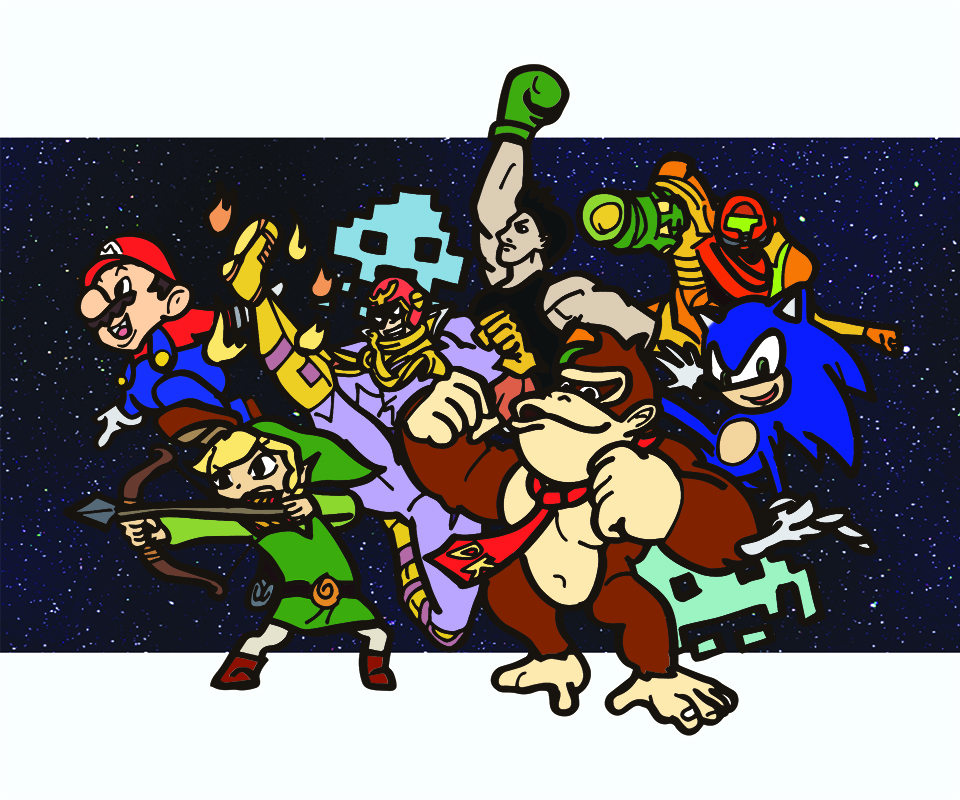Chronicling an evolution, from primitive to a seminal artform
Video games and music complement each other harmoniously. Many people have specific memories associated with the music that plays during a particular video game level, especially if it was a more difficult one. With each new generation of video game systems, sound chips, sampling fidelity and storage capabilities have influenced the sounds and textures that can be produced in a game.
Originally, video games had no music. Games like Pong (1972), Space Invaders (1978) and Breakout (1976), only had sound effects. According to a Gamespot article chronicling the history of video game music, Donkey Kong (1981) is one of the earliest examples of music in games. In 1983, with the release of the Famicom — known as the Nintendo Entertainment System (NES) in North America — video game music started to develop its own style. The opening minutes of Super Mario Bros. are iconic, partly due to the chip-tune music composed by Japan’s Koji Kondo. Many classic Nintendo games owe their sound to Kondo, including The Legend of Zelda (1986) and Punch-Out!! (1984).
My favorite tracks from that era are DuckTales’ “The Moon Theme,” composed in 1989 by Jake Kaufman, and Mega Man 3’s “Intro,” which was composed in 1990 by Harumi Fujita. Both tracks pushed the capability of the NES’s sound chip — which controls the way game systems output sound — to produce dynamic music that was melodic and atmospheric.
Competition was brewing as the 90s approached. Sega released a gaming system called Genesis in 1989, at the tailend of the NES’s popularity. The Genesis’ sound chip, the Yamaha YM2612, produced crunchy and grungy sounds, and gave composers more tools to work with. Sega’s whole aesthetic during that era was more “cool” and “punk,” and the music produced on the Genesis helped them achieve an edgier aesthetic.
Sonic the Hedgehog (1991) was the game, many fans will agree, that defined the Genesis and Sega — it was all about coolness, speed and amazing music. Even Sonic’s design took inspiration from the fashion sensibilities of Michael Jackson, particularly the buckles on Sonic’s shoes. Each level featured the rad compositions of Masato Nakamura, who had a background in Japan’s rock scene. Sonic’s soundtrack played a huge role in conveying the style the developers were going for. The dreamy bells and funky bassline of “Star Light Zone” make it a highlight from the soundtrack.
The Super Nintendo Entertainment System (SNES), or Super Famicom in other parts of the world, was released that same year. Nintendo tried to distinguish the SNES from other competitors; music played an important role. While Sega was all about attitude, Nintendo was more like 90s Disney — family friendly, yet experimental. The SNES’s sound chip (S-SMP) had a cleaner, crisper sound and better sampling capabilities. Amazing soundscapes were composed on the S-SMP. David Wise’s compositions for Donkey Kong Country (1994) were ambient and atmospheric, utilizing the sound chip to produce uniquely ambient and melodic music. “Aquatic Ambiance” is one of my favorite tracks from the game. Other games around that time, like Chrono Trigger (1995), Super Metroid (1994) and F-Zero (1990), ambitiously used music to convey grandeur, isolation and speed.
The later half of the 90s was all about 3D graphics and CD roms. Sony entered the market with the Playstation, a console that could fully render 3D objects. Therefore, it needed more storage. In order to store all the data, the system used CD roms. This allowed games to have better sounding instrumentation and the ability to use real instruments. Games started to become more cinematic in this era.
Games like Suikoden II (1998) showed off the newly available possibilities of CD technology. Tracks from the game, like “Reminiscence,” feature an orchestral sound that wouldn’t have been possible before. Castlevania: Symphony of the Night (1997) has one of my favorite soundtracks of the Playstation era. Composed by Michiru Yamane, the music stands out because of its unique gothic-rock sound.
Meanwhile, with the release of the Nintendo 64 in 1996, Nintendo decided to stick with cartridge technology. Although this decision caused some problems for the company — game developers preferred CD technology — some great music was made on the 64. The soundtracks for The Legend of Zelda: Ocarina of Time (1998) and Majora’s Mask (2000), composed by longtime Nintendo composer Kondo, have both become iconic.
Since the release of the Playstation, the trend has shifted to create more cinematic soundtracks. The Metal Gear Solid franchise even hired film composer Harry Gregson-Williams to compose soundtracks for several games. Now, soundtracks are more reactive to gameplay, changing according to the actions of the player. Nier Automata (2017) recently used an adaptive soundtrack, crafting dynamic action sequences that add and remove sound layers as the player fights a variety of enemies.
Despite technological evolution and changing industry trends, unforgettable music has always been produced by the video game industry — music that has been enmeshed in our memories. Just like the timeless games it soundtracks, video game music has so much more to explore.
Graphics by ZeZé Le Lin




